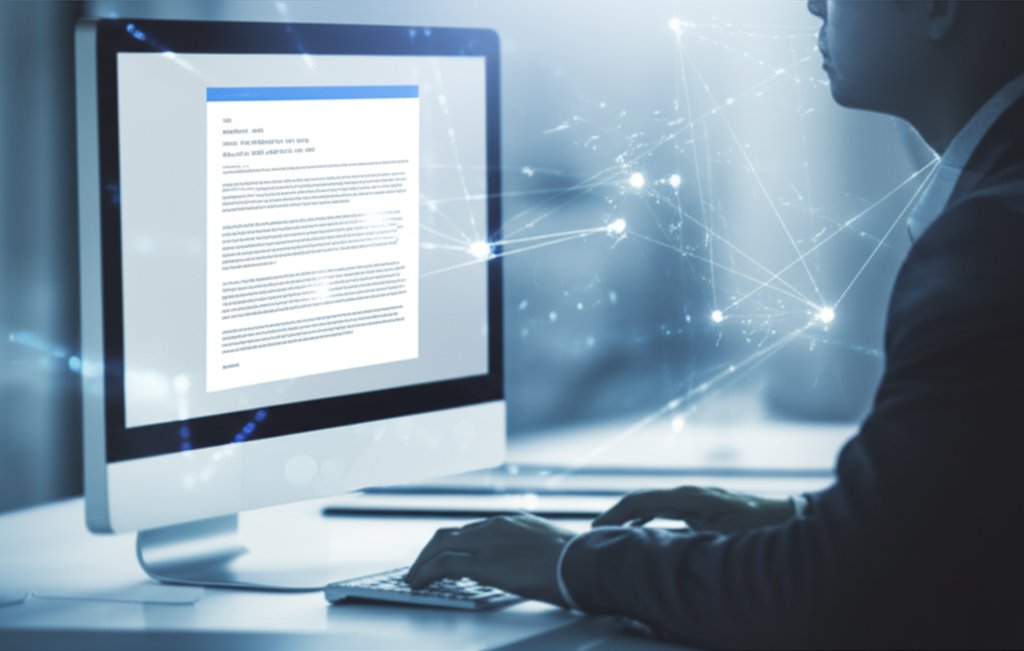Welcome to the escalating front lines of digital defense! In a world increasingly driven by artificial intelligence, cyber threats are undergoing a radical transformation. No longer confined to the realm of science fiction, AI is now being weaponized to craft disturbingly convincing phishing attacks, making them harder to spot and far more dangerous than ever before. A recent study revealed a staggering 1,265% increase in phishing attacks leveraging generative AI tools in the last year alone, costing businesses an estimated $1.2 billion annually. For everyday internet users and small businesses, understanding these sophisticated new tactics is not just an advantage—it’s your essential first line of defense.
You might associate phishing with clumsy grammar and obvious requests for your bank details. Those days, thankfully, are largely behind us. AI has fundamentally changed the game, enabling cybercriminals to create hyper-personalized scams that bypass our usual red flags and even mimic trusted voices with chilling accuracy. We are now facing an era where a seemingly legitimate email from your CEO, a convincing call from your bank, or even a video message from a colleague could be a cunning, AI-powered deception. This new level of sophistication demands a smarter, more vigilant approach to your digital security.
But don’t despair; this guide is designed to empower you with knowledge and practical tools. We will meticulously break down what makes AI-powered phishing so incredibly effective, why it poses such a significant danger, and most importantly, equip you with actionable strategies to protect yourself and your business. You’ll learn how to recognize the subtle new warning signs and fortify your digital defenses, ensuring you’re not caught off guard by these evolving threats. Let’s dive in and secure your digital world together!
Table of Contents
Basics of AI Phishing: Understanding the Evolving Threat
What is traditional phishing, and how is AI phishing different? How to detect AI phishing emails.
Traditional phishing involves cybercriminals attempting to trick you into revealing sensitive information, typically through emails, text messages, or phone calls. These attacks often contained easily identifiable red flags, such as poor grammar, generic greetings like “Dear Customer,” and suspicious, clunky links. Your natural skepticism, combined with a quick scan for obvious errors, was often enough to flag a scam.
AI phishing, however, leverages advanced artificial intelligence to make these attacks exponentially more sophisticated and convincing. AI eliminates common tell-tale signs by generating flawlessly written language, hyper-personalizing messages based on your online footprint, and even creating realistic voice or video impersonations. Think of it this way: traditional phishing was a crudely drawn stick figure; AI phishing is a photorealistic portrait, meticulously crafted to deceive. This dramatic leap in realism makes it incredibly difficult for us, and even some automated systems, to distinguish between legitimate communication and a cunning AI-powered deception.
Why are AI-powered phishing attacks considered more dangerous than older methods?
AI-powered phishing attacks are unequivocally more dangerous because they are specifically designed to bypass both traditional human skepticism and many automated security filters that rely on detecting common scam indicators. We’ve been trained to spot typos or generic messages, but AI eliminates these weaknesses, making the initial detection much harder.
Instead, AI crafts highly personalized messages that feel authentic, urgent, and contextually relevant, significantly increasing the likelihood that you’ll fall for the bait. This can manifest as mimicking the voices of trusted individuals (known as vishing) or creating convincing video impersonations (deepfakes), leading directly to financial fraud, credential theft, or the installation of malware. This unparalleled level of sophistication allows attackers to launch highly targeted campaigns at a much larger scale, exponentially increasing the overall risk to individuals and organizations alike. The sheer volume and quality of these attacks represent a significant escalation in the cyber threat landscape.
Understanding AI-Powered Effectiveness: Dissecting Sophisticated Scams
How does AI achieve hyper-personalization in phishing attacks?
AI achieves hyper-personalization by meticulously leveraging vast amounts of publicly available data, often scraped from social media profiles, professional networks like LinkedIn, corporate websites, and even public news articles. This wealth of information allows AI algorithms to construct highly detailed profiles of potential targets, which are then used to craft messages tailored specifically to you.
For example, an AI might learn about your job role, recent projects you’ve mentioned, your colleagues’ names, or even personal interests from your online presence. It then uses this data to generate an email or message that appears to come from a known contact (e.g., your CEO, a vendor, or a friend), discussing a relevant, urgent topic. This makes the message feel incredibly authentic, highly relevant, and often carries a false sense of urgency, effectively bypassing your natural skepticism. By appearing to be part of your regular work or personal life, these messages are designed to compel you to click a malicious link or provide sensitive data without a second thought.
What are deepfake phishing attacks, and how do they work? Preventing AI voice scams and deepfake deceptions.
Deepfake phishing attacks leverage AI to generate highly realistic, yet entirely fabricated, audio or video content that impersonates a specific individual. To understand why AI deepfakes are so hard to detect, consider their sophisticated evasion techniques. These incredibly deceptive tactics include AI-generated voice calls (vishing) and deepfake videos that can create convincing footage of someone saying or doing something they never did.
In a vishing scam, AI mimics the voice of someone you know—perhaps your CEO, a family member, or a key vendor—and uses it to make urgent requests over the phone, such as demanding an immediate fund transfer or sensitive information. Deepfake videos can create seemingly legitimate footage of an individual issuing instructions or making statements that are completely fabricated. These attacks exploit our innate trust in visual and auditory cues, making it extremely difficult to verify the legitimacy of a request, especially when under pressure. Imagine receiving a phone call where the voice on the other end is unmistakably your boss, asking you to transfer a significant sum of money immediately; it’s a potent and dangerous form of deception that bypasses traditional email filters and directly targets human trust.
Can AI chatbots and “AI SEO” be used as new attack vectors for phishing? Navigating AI-driven deception.
Yes, AI chatbots and a tactic we refer to as “AI SEO” are indeed emerging as new and concerning attack vectors for phishing. This represents a subtle but highly dangerous evolution in how these scams can reach you, blurring the lines between legitimate information and malicious intent.
AI chatbots, when integrated into websites, apps, or search engines, could potentially be manipulated or compromised to recommend malicious links when users ask for common login pages, product information, or even general advice. For example, if you ask a compromised chatbot, “Where do I log in to my bank account?” it might direct you to a meticulously crafted phishing site. “AI SEO” refers to attackers optimizing their malicious content to rank highly in AI-driven search summaries or chatbot responses. By ensuring their deceptive sites are presented as legitimate answers, cybercriminals can leverage the perceived authority of AI-generated information. This new frontier demands extreme vigilance: always double-check URLs, verify information through independent sources, and never blindly trust links, even when they appear to come from seemingly intelligent AI sources.
Advanced Defenses & Business Safeguards: Practical Steps Against AI Threats
What new security awareness training should I prioritize to recognize AI-driven phishing? How to train for AI phishing detection.
To effectively recognize AI-driven phishing, you must fundamentally shift your mindset from looking for obvious errors to actively questioning the authenticity and source of all digital communications. This requires a “beyond typos” approach focused on critical thinking and verification. Here’s how to prioritize your training:
- Question Everything: Adopt a “trust, but verify” mentality. Treat every unexpected or urgent request with skepticism, regardless of how perfect the grammar or how convincing the sender appears.
- Verify Sender’s True Identity: Always inspect the full email header and sender’s actual email address, not just the display name. Attackers often use legitimate-looking but subtly altered domains (e.g.,
yourcompany.coinstead ofyourcompany.com). - Hover, Don’t Click: Before clicking any link, hover your mouse over it (on desktop) or long-press (on mobile) to reveal the actual URL. Look for discrepancies between the displayed text and the underlying link.
- Cross-Verify Requests Independently: For any sensitive or urgent requests (especially financial transfers, password changes, or data sharing), use a separate, known communication channel to verify directly with the supposed sender. For instance, call them on a pre-established, trusted phone number, rather than replying to the suspicious email or calling a number provided in the suspicious message.
- Beware of Urgency and Emotional Manipulation: AI-powered attacks often create intense pressure or appeal to emotions (fear, greed, helpfulness). Recognize these psychological triggers as major red flags.
- Participate in Realistic Simulations: Engage in regular, simulated phishing exercises that include realistic, AI-generated emails, texts, and even voice messages. This practical experience is invaluable for sharpening your detection skills.
- Report Suspicious Activity: Establish a clear process for reporting any suspected phishing attempts to your IT or security team immediately. This helps protect the entire organization.
Your vigilance is the most powerful human firewall; continuous training ensures it remains impenetrable.
What essential technology can help defend against these sophisticated AI attacks? Best tech solutions for AI phishing protection.
To effectively fortify your digital gates against sophisticated AI-powered attacks, a multi-layered technological defense strategy is paramount. Here are the non-negotiable technologies you should implement:
- Multi-Factor Authentication (MFA): This is arguably your single most critical defense. MFA adds an extra layer of security beyond just a password, requiring a second form of verification (e.g., a code from your phone, a fingerprint scan, or a hardware key). For more on bolstering your email defenses, including MFA, consider these critical email security mistakes to avoid. Even if an AI phishing attack successfully steals your password, MFA prevents unauthorized access, rendering the stolen credential useless to the attacker. Implement MFA everywhere possible.
- Strong, Unique Passwords & Password Managers: Utilize strong, complex, and unique passwords for every single account. A reputable password manager is essential for generating, storing, and managing these credentials securely, making it easy to comply with best practices without memorizing dozens of intricate passwords.
- Advanced Email & Spam Filters: Invest in email security solutions that leverage AI and machine learning themselves to detect subtle anomalies, behavioral patterns, and emerging threats that traditional filters might miss. These tools can identify sophisticated phishing attempts, malicious attachments, and suspicious links before they ever reach your inbox, often utilizing sandboxing to inspect dubious content safely.
- Regular Software Updates and Patching: Keep all your software—including operating systems, web browsers, applications, and security tools—regularly updated. Software vendors frequently release patches to fix known vulnerabilities that attackers, including AI-powered ones, might exploit.
- Robust Antivirus and Anti-Malware Software: Ensure all your devices (computers, smartphones, tablets) have up-to-date antivirus and anti-malware software with behavioral detection capabilities. This provides a crucial baseline of protection against malicious payloads delivered by phishing attempts, detecting and neutralizing threats that might slip through other defenses.
- DNS Filtering and Web Security Gateways: Implement DNS filtering to block access to known malicious websites and suspicious domains at the network level. Web security gateways can inspect web traffic for threats and prevent users from accessing phishing sites even if they click a malicious link.
These technologies, when combined, create a formidable defense perimeter, significantly reducing your exposure to AI-driven cyber threats.
What specific safeguards should small businesses implement to protect against AI phishing? Small business cybersecurity against AI threats.
Small businesses, often perceived as easier targets due to potentially fewer dedicated resources, require tailored and robust safeguards against the rising tide of AI-powered phishing. Implementing these specific measures can significantly bolster your resilience:
- Implement Strict Verification Protocols for Sensitive Transactions: Establish a “two-person rule” or dual authorization for all financial transactions, particularly fund transfers, and for sharing sensitive company data. This means no payments or major data releases without a secondary verification method—for example, a phone call to a known, pre-established number (not one provided in the email), or an in-person confirmation.
- Enforce Least Privilege Access: Ensure employees only have access to the data, systems, and applications absolutely necessary for their specific job role. This principle is a cornerstone of the Zero Trust security model, minimizing the potential damage if an employee’s account is compromised through an AI phishing attack, preventing attackers from gaining widespread access to your critical assets. Regularly review and update access permissions.
- Develop a Robust Data Backup and Recovery Plan: Implement a comprehensive strategy for regularly backing up all critical business data. Ensure these backups are stored offsite, encrypted, and routinely tested for restorability. In the event an AI phishing attack leads to ransomware or data loss, a reliable backup allows for swift recovery and minimizes business disruption.
- Adopt AI-Powered Security Tools for Business: Consider investing in advanced security tools that utilize AI and machine learning, even without an extensive in-house IT team. This can include intelligent email filtering solutions, Endpoint Detection and Response (EDR) platforms, or Security Information and Event Management (SIEM) systems designed for smaller enterprises. These tools can detect subtle behavioral anomalies and augment your existing defenses by proactively identifying and responding to threats.
- Create a Clear Incident Response Plan: Develop a simple, easy-to-understand incident response plan that outlines specific, step-by-step actions to take immediately if a phishing attempt is suspected or a breach occurs. This plan should include who to contact, how to isolate compromised systems, and communication protocols. Regular drills help employees internalize these crucial steps, minimizing potential damage and recovery time.
- Provide Continuous Security Awareness Training: Regularly train employees on the latest phishing tactics, including AI-driven methods. Emphasize the importance of vigilance, reporting suspicious activities, and adhering to verification protocols. Make security a part of your company culture.
By implementing these specific safeguards, small businesses can effectively elevate their cybersecurity posture and create a formidable defense against AI-powered phishing threats.
Related Questions & Future Outlook
Is AI also used to defend against cyberattacks, creating an “arms race”?
Absolutely, AI is very much a double-edged sword in cybersecurity, and it’s definitely creating an “arms race” between malicious actors and diligent defenders. While cybercriminals are harnessing AI to launch more sophisticated phishing and other cyberattacks, cybersecurity professionals are equally employing AI and machine learning to bolster defenses, often at an unprecedented scale and speed.
AI-powered security tools can analyze vast amounts of data—far more than any human team could—to detect unusual patterns, identify new and emerging threats faster, predict potential attack vectors, and automate responses to rapidly evolving threats. For example, AI-powered security orchestration can significantly improve incident response. It’s a continuous, dynamic cat-and-mouse game; as attackers refine their AI-driven methods to bypass defenses, defenders must continuously adapt and deploy their own AI capabilities to stay one step ahead, making for an ongoing technological struggle for digital dominance.
How can I stay updated on the latest AI phishing tactics and defenses? Continuous learning for cybersecurity awareness.
Staying updated on the latest AI phishing tactics and defenses is crucial for continuous protection, and fortunately, there are many accessible and authoritative resources available. Proactive learning is your best defense against rapidly evolving threats:
- Follow Reputable Cybersecurity Blogs and News Outlets: Regularly read and subscribe to blogs from leading cybersecurity firms (e.g., Palo Alto Networks, Fortinet, CrowdStrike), as well as dedicated tech and security news sites. These platforms often provide timely analysis of new attack methods and defensive strategies.
- Review Industry Threat Reports and Whitepapers: Many cybersecurity firms, research organizations, and government agencies (like the Cybersecurity and Infrastructure Security Agency, CISA, in the U.S., or ENISA in Europe) publish regular threat reports and whitepapers that detail emerging attack vectors, including those leveraging AI, and recommended countermeasures.
- Subscribe to Security Newsletters and Alerts: Sign up for newsletters from security vendors, industry associations, and government cybersecurity agencies. These often deliver timely alerts, advisories, and expert insights directly to your inbox.
- Engage with Cybersecurity Communities: Participate in online forums, professional groups (e.g., on LinkedIn), or communities focused on cybersecurity awareness. These platforms can offer real-time insights, practical advice, and discussions on new threats and solutions.
- Consider Online Courses or Certifications: For a deeper dive, explore online courses or certifications in cybersecurity fundamentals, threat intelligence, or ethical hacking. Many platforms offer introductory modules that can significantly enhance your understanding.
- Attend Webinars and Virtual Conferences: Many organizations host free webinars and virtual conferences discussing the latest cybersecurity trends, including AI threats. These are excellent opportunities to learn from experts and ask questions.
Remember, the best defense is a proactive, curious mindset. Always question unexpected digital communications and prioritize continuous learning about digital threats to safeguard yourself and your assets effectively.
Don’t Be a Target: Stay Informed, Stay Safe
The relentless rise of AI-powered phishing attacks marks a significant and dangerous evolution in the cyber threat landscape. No longer are we merely guarding against obvious scams; we are now defending against highly intelligent, hyper-personalized deceptions that can mimic trusted sources with alarming and convincing accuracy. These sophisticated threats demand a higher level of vigilance and a smarter approach to digital security.
But as we’ve explored, recognizing these new tactics and implementing robust defenses—both human and technological—can absolutely empower you to effectively protect yourself and your business. Your vigilance is your strongest shield. By understanding precisely how AI amplifies phishing, embracing smarter security awareness training, and fortifying your digital defenses with non-negotiable measures like Multi-Factor Authentication, strong password management, and advanced security tools, you can significantly reduce your risk.
Stay informed, cultivate a healthy skepticism for everything that feels even slightly off, and make continuous digital security a priority in your daily routine. Together, we can outsmart these AI-driven deceptions and keep our digital lives, and our businesses, safe and secure.





